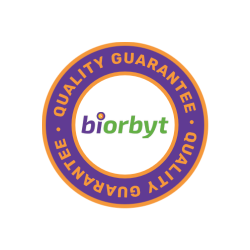You have no items in your shopping cart.
Anti-RbAp48 RBBP4 Antibody (monoclonal, 9F3)
Catalog Number: orb443139
| Catalog Number | orb443139 |
|---|---|
| Category | Antibodies |
| Description | Anti-RbAp48 RBBP4 Antibody (monoclonal, 9F3). Tested in IHC, WB applications. This antibody reacts with Human, Mouse, Rat. |
| Species/Host | Mouse |
| Clonality | Monoclonal |
| Clone Number | 9F3 |
| Tested applications | IHC, WB |
| Reactivity | Human, Mouse, Rat |
| Isotype | Mouse IgG1 |
| Immunogen | A synthetic peptide corresponding to a sequence at the C-terminus of human RbAp48, identical to the related mouse sequence. |
| Antibody Type | Primary Antibody |
| Concentration | Adding 0.2 ml of distilled water will yield a concentration of 500 μg/ml. |
| Form/Appearance | Lyophilized |
| Conjugation | Unconjugated |
| MW | 55 kDa |
| UniProt ID | Q09028 |
| Storage | Maintain refrigerated at 2-8°C for up to 2 weeks. For long term storage store at -20°C in small aliquots to prevent freeze-thaw cycles. |
| Alternative names | Histone-binding protein RBBP4; Chromatin assembly Read more... |
| Note | For research use only |
| Application notes | Western blot, 0.1-0.5μg/ml Immunohistochemistry (Paraffin-embedded Section), 0.5-1μg/ml. Add 0.2ml of distilled water will yield a concentration of 500ug/ml |
| Expiration Date | 12 months from date of receipt. |
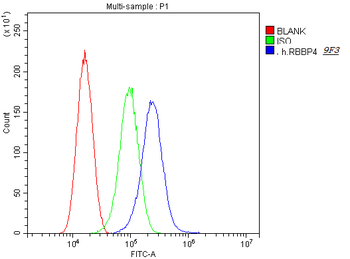
Flow Cytometry analysis of SiHa cells using anti-RbAp48 antibody. Overlay histogram showing SiHa cells (Blue line). The cells were blocked with 10% normal goat serum. And then incubated with mouse anti-RbAp48 Antibody (1 µg/1x10^6 cells) for 30 min at 20°C. DyLight®488 conjugated goat anti-mouse IgG (5-10 µg/1x10^6 cells) was used as secondary antibody for 30 minutes at 20°C. Isotype control antibody (Green line) was rabbit IgG (1 µg/1x10^6) used under the same conditions. Unlabelled sample (Red line) was also used as a control.
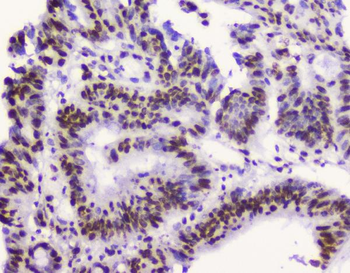
IHC analysis of RbAp48 using anti-RbAp48 antibody. RbAp48 was detected in paraffin-embedded section of human intestinal cancer tissue. Heat mediated antigen retrieval was performed in citrate buffer (pH6, epitope retrieval solution) for 20 mins. The tissue section was blocked with 10% goat serum. The tissue section was then incubated with 2 µg/ml mouse anti-RbAp48 Antibody overnight at 4°C. Biotinylated goat anti-mouse IgG was used as secondary antibody and incubated for 30 minutes at 37°C. The tissue section was developed using Strepavidin-Biotin-Complex (SABC) with DAB as the chromogen.
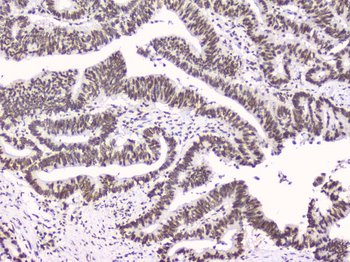
IHC analysis of RbAp48 using anti-RbAp48 antibody. RbAp48 was detected in paraffin-embedded section of human intestinal cancer tissues. Heat mediated antigen retrieval was performed in citrate buffer (pH6, epitope retrieval solution) for 20 mins. The tissue section was blocked with 10% goat serum. The tissue section was then incubated with 1 µg/ml mouse anti-RbAp48 Antibody overnight at 4°C. Biotinylated goat anti-mouse IgG was used as secondary antibody and incubated for 30 minutes at 37°C. The tissue section was developed using Strepavidin-Biotin-Complex (SABC) with DAB as the chromogen.
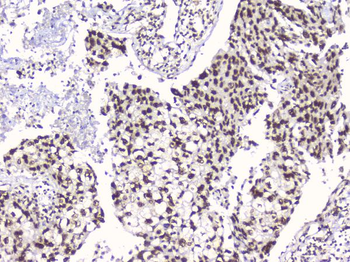
IHC analysis of RbAp48 using anti-RbAp48 antibody. RbAp48 was detected in paraffin-embedded section of human lung cancer tissues. Heat mediated antigen retrieval was performed in citrate buffer (pH6, epitope retrieval solution) for 20 mins. The tissue section was blocked with 10% goat serum. The tissue section was then incubated with 1 µg/ml mouse anti-RbAp48 Antibody overnight at 4°C. Biotinylated goat anti-mouse IgG was used as secondary antibody and incubated for 30 minutes at 37°C. The tissue section was developed using Strepavidin-Biotin-Complex (SABC) with DAB as the chromogen.
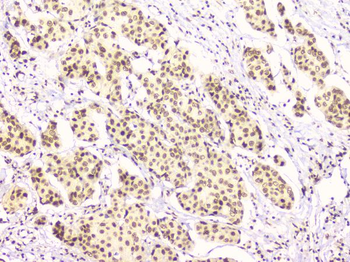
IHC analysis of RbAp48 using anti-RbAp48 antibody. RbAp48 was detected in paraffin-embedded section of human mammary cancer tissues. Heat mediated antigen retrieval was performed in citrate buffer (pH6, epitope retrieval solution) for 20 mins. The tissue section was blocked with 10% goat serum. The tissue section was then incubated with 1 µg/ml mouse anti-RbAp48 Antibody overnight at 4°C. Biotinylated goat anti-mouse IgG was used as secondary antibody and incubated for 30 minutes at 37°C. The tissue section was developed using Strepavidin-Biotin-Complex (SABC) with DAB as the chromogen.
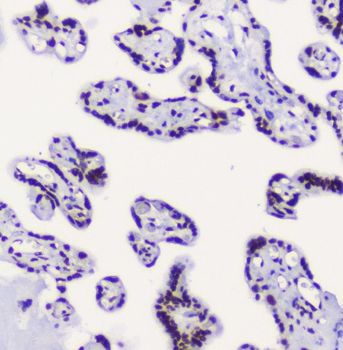
IHC analysis of RbAp48 using anti-RbAp48 antibody. RbAp48 was detected in paraffin-embedded section of human placenta tissue. Heat mediated antigen retrieval was performed in citrate buffer (pH6, epitope retrieval solution) for 20 mins. The tissue section was blocked with 10% goat serum. The tissue section was then incubated with 2 µg/ml mouse anti-RbAp48 Antibody overnight at 4°C. Biotinylated goat anti-mouse IgG was used as secondary antibody and incubated for 30 minutes at 37°C. The tissue section was developed using Strepavidin-Biotin-Complex (SABC) with DAB as the chromogen.
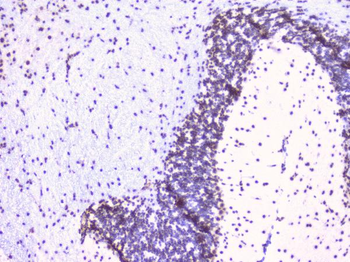
IHC analysis of RbAp48 using anti-RbAp48 antibody. RbAp48 was detected in paraffin-embedded section of mouse brain tissues. Heat mediated antigen retrieval was performed in citrate buffer (pH6, epitope retrieval solution) for 20 mins. The tissue section was blocked with 10% goat serum. The tissue section was then incubated with 1 µg/ml mouse anti-RbAp48 Antibody overnight at 4°C. Biotinylated goat anti-mouse IgG was used as secondary antibody and incubated for 30 minutes at 37°C. The tissue section was developed using Strepavidin-Biotin-Complex (SABC) with DAB as the chromogen.
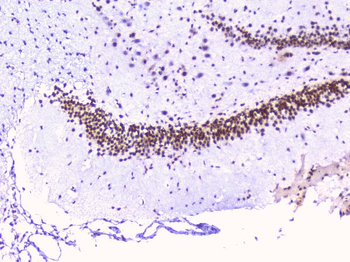
IHC analysis of RbAp48 using anti-RbAp48 antibody. RbAp48 was detected in paraffin-embedded section of rat brain tissues. Heat mediated antigen retrieval was performed in citrate buffer (pH6, epitope retrieval solution) for 20 mins. The tissue section was blocked with 10% goat serum. The tissue section was then incubated with 1 µg/ml mouse anti-RbAp48 Antibody overnight at 4°C. Biotinylated goat anti-mouse IgG was used as secondary antibody and incubated for 30 minutes at 37°C. The tissue section was developed using Strepavidin-Biotin-Complex (SABC) with DAB as the chromogen.
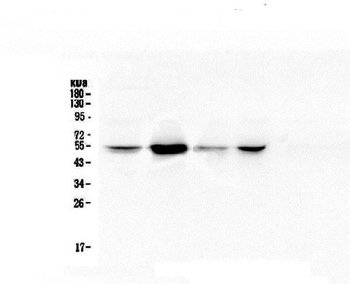
Western blot analysis of RbAp48 using anti-RbAp48 antibody. Electrophoresis was performed on a 10% SDS-PAGE gel at 70V (Stacking gel) / 90V (Resolving gel) for 2-3 hours. The sample well of each lane was loaded with 50 ug of sample under reducing conditions. Lane 1: human A549 whole cell lysate, Lane 2: human Jurkat whole cell lysate, Lane 3: human Hela whole cell lysate, Lane 4: human PANC-1 whole cell lysate. After Electrophoresis, proteins were transferred to a Nitrocellulose membrane at 150mA for 50-90 minutes. Blocked the membrane with 5% Non-fat Milk/ TBS for 1.5 hour at RT. The membrane was incubated with mouse anti-RbAp48 antigen affinity purified monoclonal antibody at 0.5 µg/mL overnight at 4°C, then washed with TBS-0.1% Tween 3 times with 5 minutes each and probed with a goat anti-mouse IgG-HRP secondary antibody at a dilution of 1:10000 for 1.5 hour at RT. The signal is developed using an Enhanced Chemiluminescent detection (ECL) kit with Tanon 5200 system.
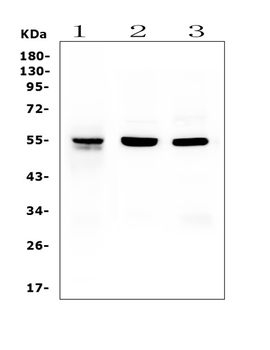
Western blot analysis of RbAp48 using anti-RbAp48 antibody. Electrophoresis was performed on a 5-20% SDS-PAGE gel at 70V (Stacking gel) / 90V (Resolving gel) for 2-3 hours. The sample well of each lane was loaded with 50 ug of sample under reducing conditions. Lane 1: human Jurkat whole cell lysates Lane 2: rat thymus tissue lysates Lane 3: mouse spleen tissue lysates After Electrophoresis, proteins were transferred to a Nitrocellulose membrane at 150mA for 50-90 minutes. Blocked the membrane with 5% Non-fat Milk/ TBS for 1.5 hour at RT. The membrane was incubated with mouse anti-RbAp48 antigen affinity purified monoclonal antibody at 0.5 µg/mL overnight at 4°C, then washed with TBS-0.1% Tween 3 times with 5 minutes each and probed with a goat anti-mouse IgG-HRP secondary antibody at a dilution of 1:10000 for 1.5 hour at RT. The signal is developed using an Enhanced Chemiluminescent detection (ECL) kit with Tanon 5200 system. A specific band was detected for RbAp48 at approximately 55KD. The expected band size for RbAp48 is at 48KD.
Anti-RbAp48 RBBP4 Antibody (monoclonal, 9F3) [orb2611325]
IHC, WB
Human, Mouse, Rat
Mouse
Monoclonal
iFluor647
100 μgAnti-RbAp48 RBBP4 Antibody (monoclonal, 9F3) [orb2611326]
IHC, WB
Human, Mouse, Rat
Mouse
Monoclonal
PE
100 μgAnti-RbAp48 RBBP4 Antibody (monoclonal, 9F3) [orb2611327]
IHC, WB
Human, Mouse, Rat
Mouse
Monoclonal
APC
100 μgAnti-RbAp48 RBBP4 Antibody (monoclonal, 9F3) [orb2611328]
IHC, WB
Human, Mouse, Rat
Mouse
Monoclonal
HRP
100 μgAnti-RbAp48 RBBP4 Antibody (monoclonal, 9F3) [orb2611329]
IHC, WB
Human, Mouse, Rat
Mouse
Monoclonal
FITC
100 μg


